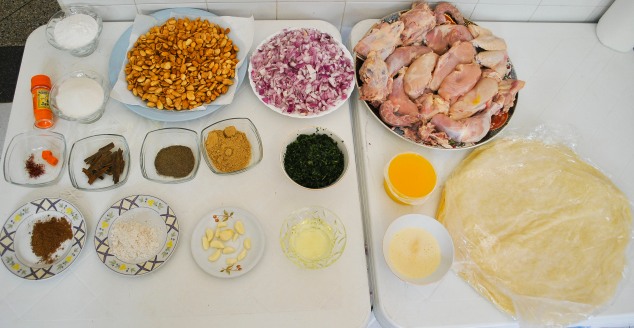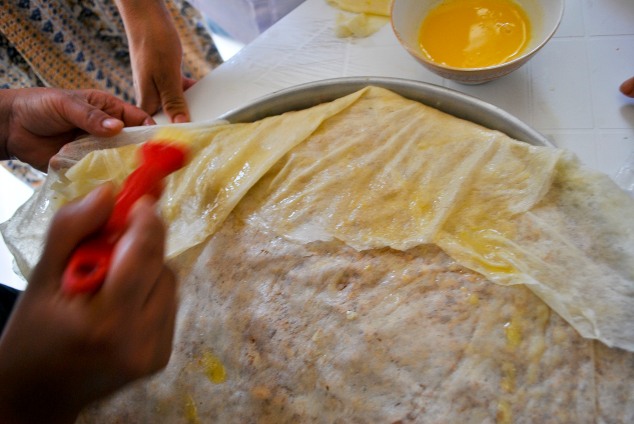Bastila is a Moroccan dish made from chicken, eggs and almonds, layered and wrapped in phylo dough. The word comes from Spanish “pastilla” which I am assuming refers to the thin crispy layers of dough. Who knows if this dish still exists in Spain, but “history” (i.e. wikipedia) tells us that the Moors brought this dish with them when they were driven out of Spain in the late 1400’s. Today it is served ubiquitously at special occasions, usually as an appetizer ahead of a meat dish.
I’ve been wracking my brains for ideas to help some of the struggling ladies I know, which is hard to do since my brain actually liquefied and oozed out of my ears a long time ago in this 110 degree heat. But thankfullyI retained that 10 percent of our brains that we actually use. So it dawned on me that knowing how to make bastila is a potentially marketable skill. In Morocco, women who know how to make it can get commissioned by their neighbors or by local catering companies. It’s something they can do at home and at their own pace. But for a large number of Moroccan women, there are two basic challenges when it comes to a home industry like making bastila. One is illiteracy. So they can’t read recipes, something most of us take for granted. Another challenge is not being able to afford the ingredients in order to practice a few times. These things pose such a huge mental block that women won’t even try.
I wanted to find a way to overcome both challenges. The idea came to have a series of cooking classes, free to the participants, funded by outside donations. We held the first one last Sunday, at the school I work at CLC Morocco (www.clcmorocco.org). When our school cook, Khadija, heard about the project, she immediately volunteered to teach the class. Khadija is great cook, but more than that she has a fun-loving confident personality that puts even the shyest and most awkward among us at ease. As for the participants, we started with a small group of 5 women, some of whom I’ve blogged about here, so if you’ve been reading, you have an idea of the challenges these women face.
As they worked, I took pictures in order to make a picture recipe book that the women can follow another time. Seeing and participating in making the dish the first time would give them the initial confidence they would need to try it again.
First they prepared and laid out all the ingredients. From left to right, top: powdered sugar and regular, 1 kg almonds, 1 kg onions, 2 chickens; middle row: 1 gram saffron threads, fake saffron food coloring, 3 cinnamon sticks, peppe, ginger, chopped coriander, smen (ghee), and 1 kg of the bastila sheets called warqa in Arabic; last row: Ras el Hanout spice mix, salt, 3-4 garlic cloves, oil, melted butter. Missing from this picture are 15 eggs and orange blossom water.
I have to warn you, making bastila is a long process. It’s a labor of love that I don’t actually expect you or myself to make. But just for fun, here’s how it’s done.
First, the chicken is set to stew with lots of salt, pepper, ground ginger, ras el hanout (about 2 large spoons each, Moroccan cooks don’t give exact measurements). There is also a good cup of oil, about a quarter cup of smen (gheen), the onions, garlic, saffron and coriander. Khadija told us that some people prefer to leave the coriander whole in a small bouquet, then fish it out at the end. She prefers to add it chopped, but she said “you do it however you want”. That is basically the philosophy behind Moroccan cooking, measurements are eyeballed, the dish is tasted at various intervals and tweeked, and no two cooks will make the same exact recipe.
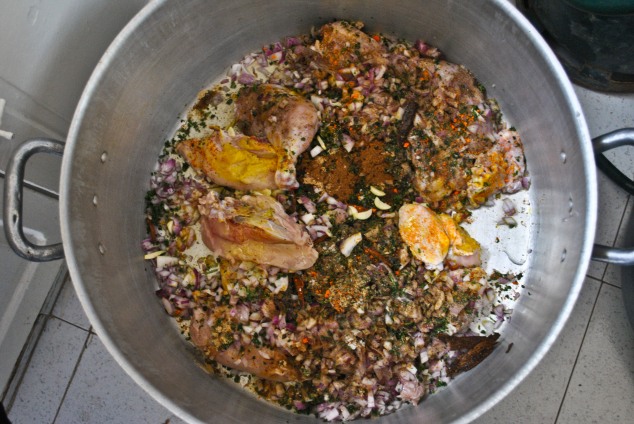
Stir the chicken in the pot. It’s going to smell really good really quick, but don’t start to falter, although your mouth may start to water, the end is *not* in sight. 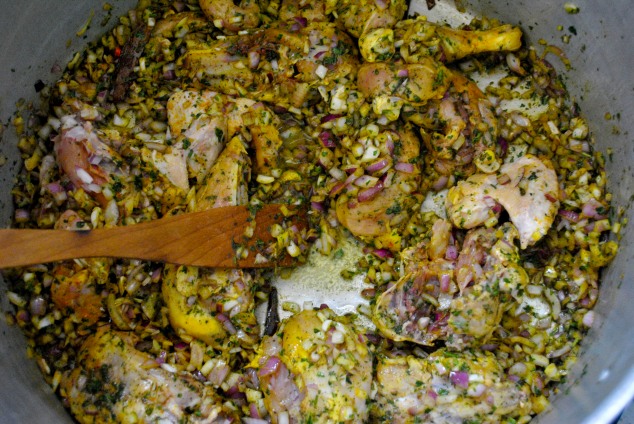
Good yellow chicken. Moroccans will not tolerate white chicken. While the chicken is cooking, you can work on the almonds, see bellow.
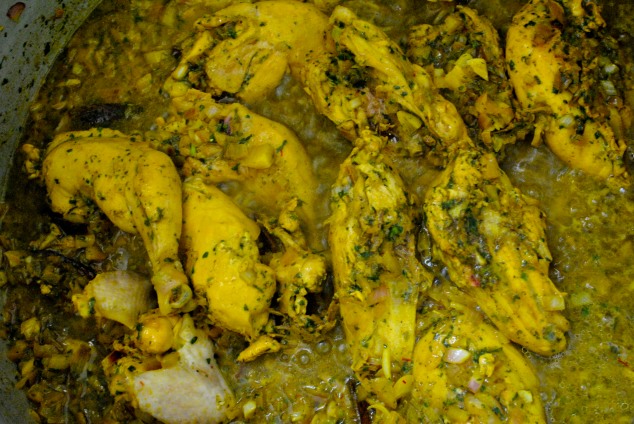
When it’s good and cooked, the chicken is removed from the sauce, left to cool and de-boned. Stage one complete.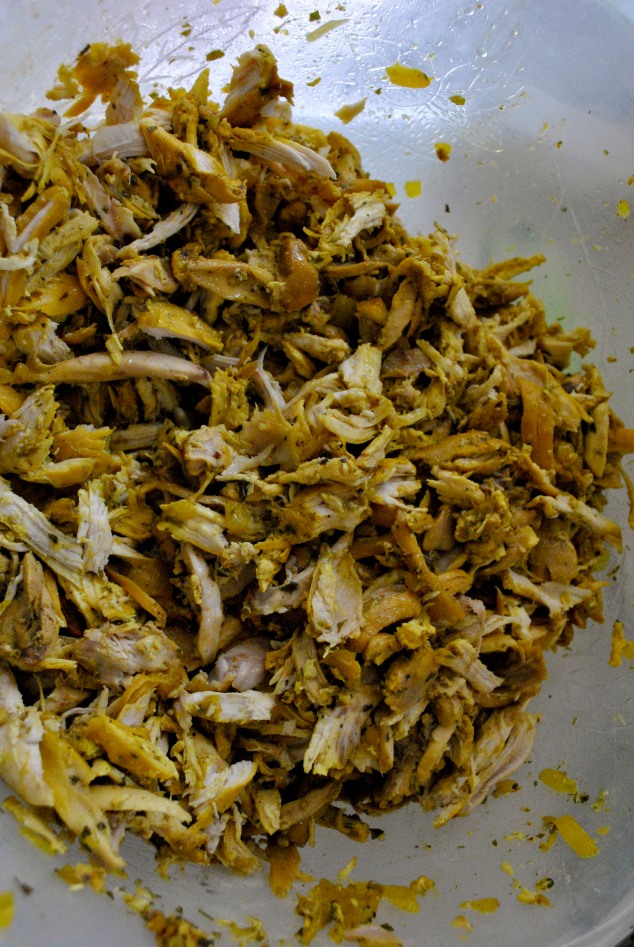
Next, skim off a small bowlful of the sauce, add it to the chicken to avoid dryness. Now start the egg stage. About 12 or so eggs will be broken straight into the sauce and stirred.
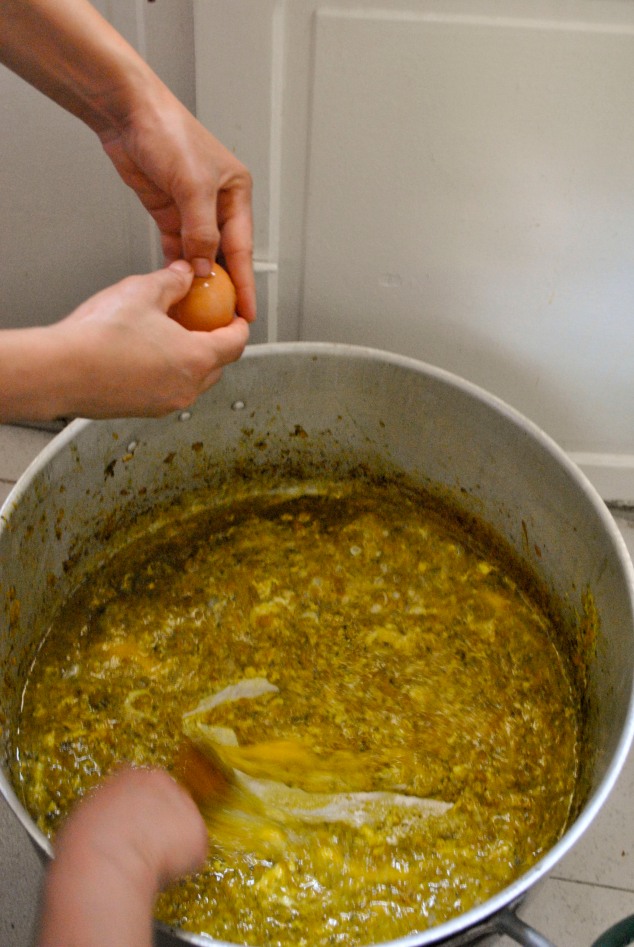
Keep stirring until they look like this. Then transfer them to a colander and let all the excess water drain out. Stage 2 complete. 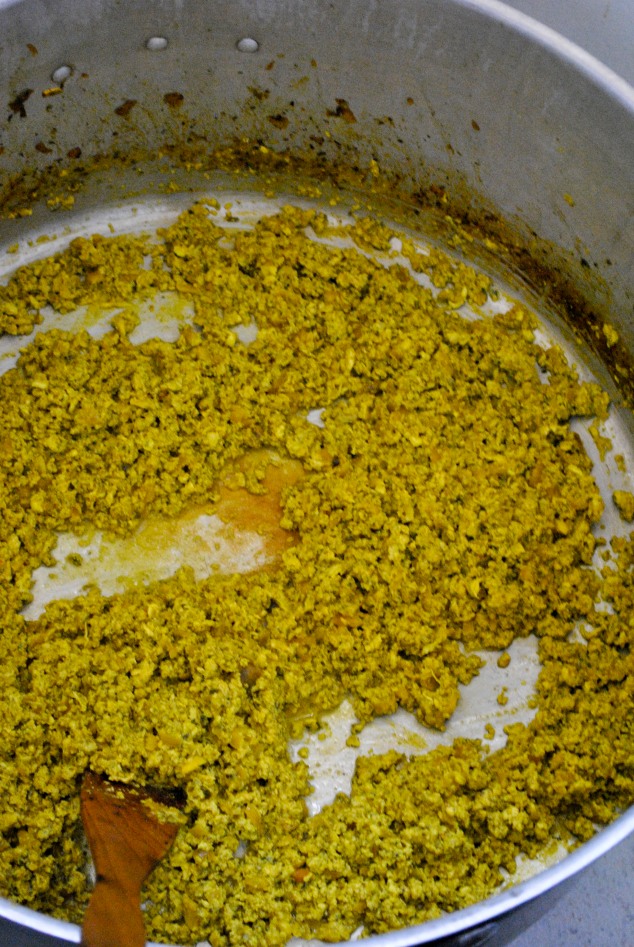
The almonds now. These take a while so it’s best if you do this step the day before. It’s tedious and depressing to do this alone, be warned, so call your friends and make it a bastila-making party. In our cooking class, there were like 5 ladies plus Khadija plus me working, cleaning, laughing (in my case, snapping photos and running out for random ingredients that we ran out of) and it still took about 2-3 hours from start to finish. The almonds need to be washed, boiled, skinned, dried, and fried. If you know Moroccan cooking, then you know what I mean. For the bastila, Khadija’s method was to take the now prepared almonds and add cinnamon (1 large spoon), regular sugar (a bowlful, to taste, personally I like mine good and sweet), a few tablespoons of orange blossom water. Then the almonds are pulsed in a food processor until they are coarsely ground. Then Khadija added a good half a cup or so of melted butter. Mmm!
Stage 3 complete. Now on to the great assembling of the bastila. Here you have 2 things on hand, a bowlful of melted butter (check your diet at the door) and a bowl with 2 beaten eggs (remember the eggs are the glue that keeps the bastila sheets together). In Morocco, we order bastila sheets at the local bakery the day before.
First butter the pan. Lay the first sheet down, half hanging out of the pan.
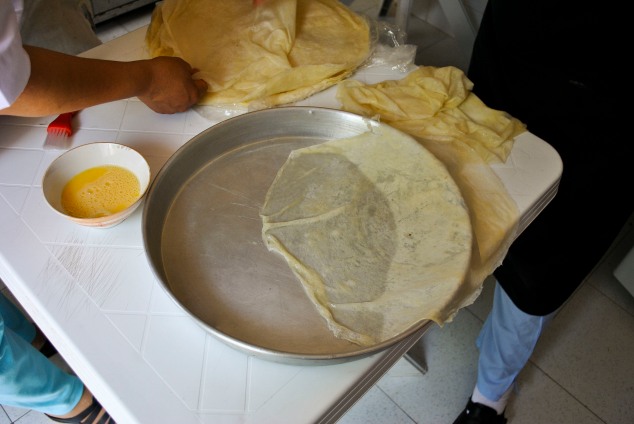
Add four more overlapping sheet, brushing egg in between them, and brushing butter on top.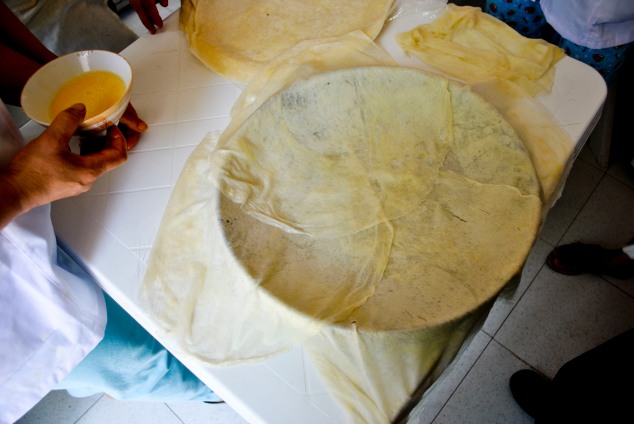
A fifth sheet is added in the center, egged and buttered.
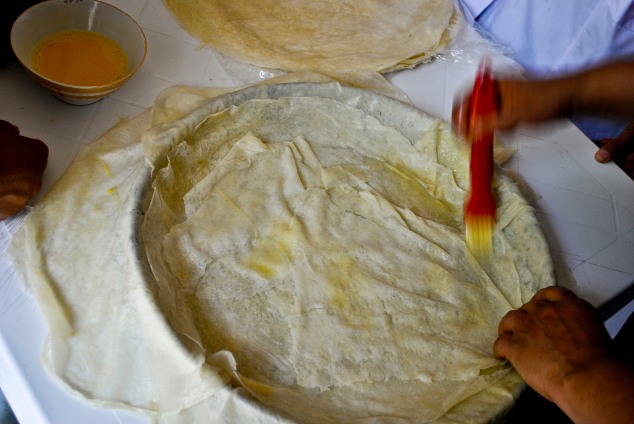
Now take your chicken and eggs and mix them up (who cares which came first, hehe). Lay them down for the first layer. It should be a good 1.5 – 2.5 inches thick. With the amounts we used, we had a good third left over (we made little bastilas out of the leftover filling).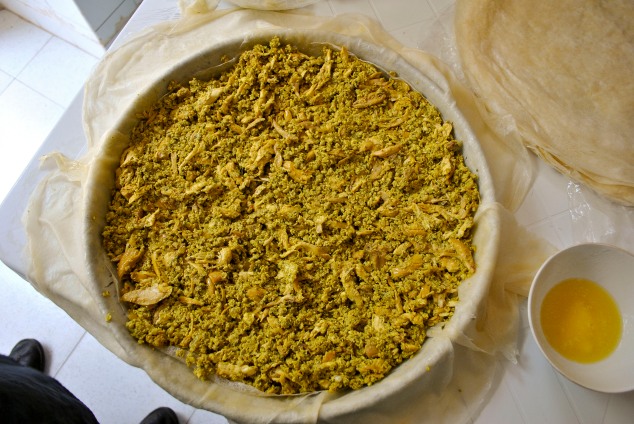
Place a bastila sheet over that layer. Not everyone does this, some prefer to just add the almonds directly. 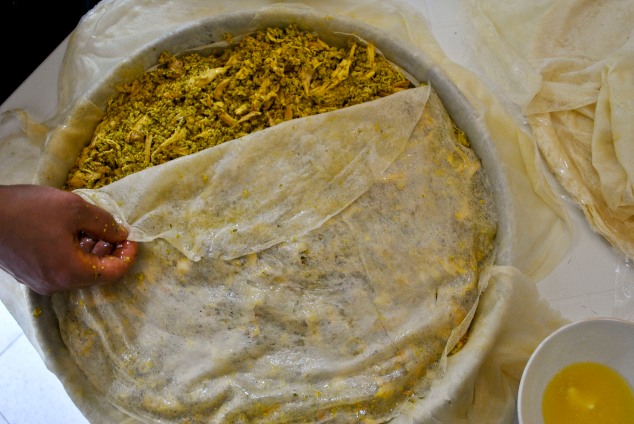
Now add the coarsely ground almonds.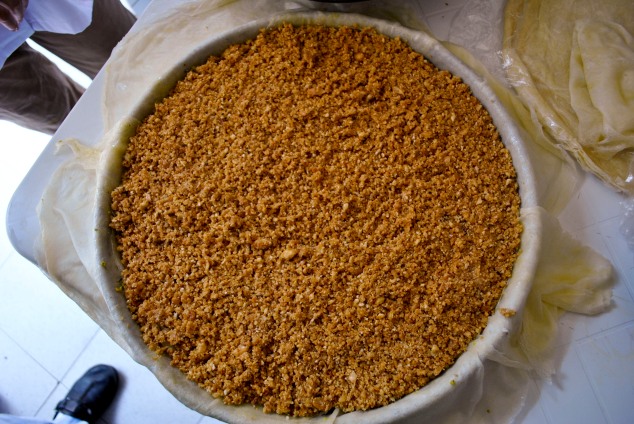
Now add another bastila sheet smack dab in the middle, and start to fold all the flaps over. 
At the very end, you add one last bastila sheet to cover the whole thing. Tuck it in nicely all around and butter the top.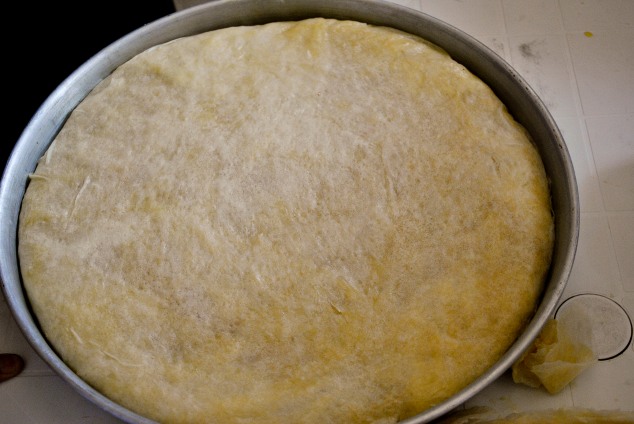
Put it in to cook, about 45 minutes, until the bastila is golden brown and crispy. At this point I sort of dropped the ball on photos and did not get a PHOTO OF THE FINISHED BASTILA. Doh! At the end, you decorate it with powdered sugar and cinnamon. It is so good, I’d place it among the top 5 best Moroccan dishes. Oh yeah, and you can’t get it in restaurants, well, not really, unless you go to those swanky places that serve pigeon bastila at exorbitant prices. Homemade is always better!
But you can sort of see it in this picture along with the apprentice cooks.
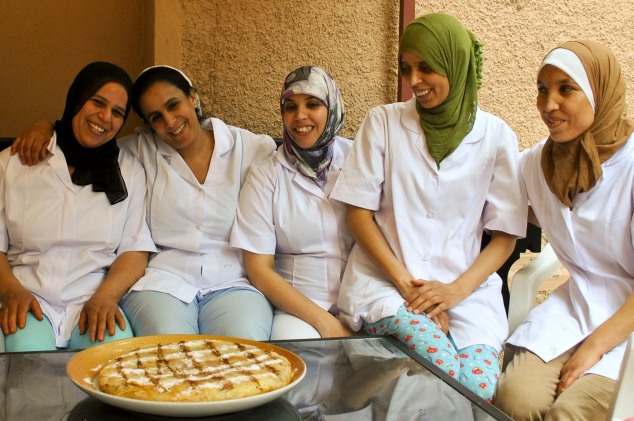 It was such an enjoyable day. I think the ladies learned a lot from Khadija (she’s second from left here). She has had lots of experience cooking for riads and for catering services, so she has the confidence it takes. These women on the other hand, have worked mostly as maids, receiving orders, so maybe do not have that confidence. The cost of the ingredients for this dish and the fruit tarts they made afterwards was about 300 dirhams (40 dollars). It’s not a lot, but in Morocco it can be a week’s salary. Someone had given me this money and said, do something for the ladies. This turned out to be an awesome use of the money. Khadija also insisted that we buy the ladies proper white uniforms, which made them feel like real students. And these ladies who are so used to serving others, their employers and families, well on this day they were the guests of honor, since we all sat down and ate the bastila together. For me, it was a perfect day combining several of my favorite things (things I have not yet figured out how to get paid for doing, lol): networking, planning, empowering women, photography, eating and finally breaking through the blogger’s block!
It was such an enjoyable day. I think the ladies learned a lot from Khadija (she’s second from left here). She has had lots of experience cooking for riads and for catering services, so she has the confidence it takes. These women on the other hand, have worked mostly as maids, receiving orders, so maybe do not have that confidence. The cost of the ingredients for this dish and the fruit tarts they made afterwards was about 300 dirhams (40 dollars). It’s not a lot, but in Morocco it can be a week’s salary. Someone had given me this money and said, do something for the ladies. This turned out to be an awesome use of the money. Khadija also insisted that we buy the ladies proper white uniforms, which made them feel like real students. And these ladies who are so used to serving others, their employers and families, well on this day they were the guests of honor, since we all sat down and ate the bastila together. For me, it was a perfect day combining several of my favorite things (things I have not yet figured out how to get paid for doing, lol): networking, planning, empowering women, photography, eating and finally breaking through the blogger’s block!

